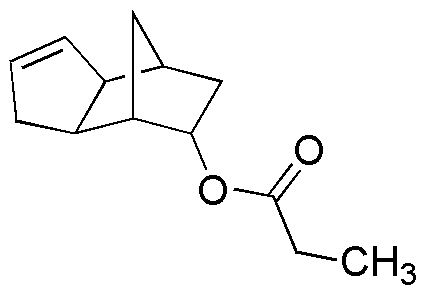Tricyclodecenyl propionate is widely utilized in research focused on:
- Fragrance Industry: This compound serves as a key ingredient in perfumes and scented products, providing a unique and long-lasting aroma that enhances consumer appeal.
- Cosmetics: It is used in various cosmetic formulations, such as lotions and creams, where it acts as a fragrance component and skin conditioning agent, improving product texture and scent.
- Aromatherapy: The compound is incorporated into essential oil blends for its pleasant scent and potential mood-enhancing properties, making it popular in wellness products.
- Food Industry: Tricyclodecenyl propionate can be used as a flavoring agent in food products, contributing to the overall sensory experience of consumers.
- Research Applications: In academic and industrial research, it is studied for its chemical properties and potential applications in developing new fragrances or flavor compounds, offering insights into molecular interactions.
General Information
Properties
Safety and Regulations
Applications
Tricyclodecenyl propionate is widely utilized in research focused on:
- Fragrance Industry: This compound serves as a key ingredient in perfumes and scented products, providing a unique and long-lasting aroma that enhances consumer appeal.
- Cosmetics: It is used in various cosmetic formulations, such as lotions and creams, where it acts as a fragrance component and skin conditioning agent, improving product texture and scent.
- Aromatherapy: The compound is incorporated into essential oil blends for its pleasant scent and potential mood-enhancing properties, making it popular in wellness products.
- Food Industry: Tricyclodecenyl propionate can be used as a flavoring agent in food products, contributing to the overall sensory experience of consumers.
- Research Applications: In academic and industrial research, it is studied for its chemical properties and potential applications in developing new fragrances or flavor compounds, offering insights into molecular interactions.
Documents
Safety Data Sheets (SDS)
The SDS provides comprehensive safety information on handling, storage, and disposal of the product.
Product Specification (PS)
The PS provides a comprehensive breakdown of the product’s properties, including chemical composition, physical state, purity, and storage requirements. It also details acceptable quality ranges and the product's intended applications.
Certificates of Analysis (COA)
Search for Certificates of Analysis (COA) by entering the products Lot Number. Lot and Batch Numbers can be found on a product’s label following the words ‘Lot’ or ‘Batch’.
*Catalog Number
*Lot Number
Certificates Of Origin (COO)
This COO confirms the country where the product was manufactured, and also details the materials and components used in it and whether it is derived from natural, synthetic, or other specific sources. This certificate may be required for customs, trade, and regulatory compliance.
*Catalog Number
*Lot Number
Safety Data Sheets (SDS)
The SDS provides comprehensive safety information on handling, storage, and disposal of the product.
DownloadProduct Specification (PS)
The PS provides a comprehensive breakdown of the product’s properties, including chemical composition, physical state, purity, and storage requirements. It also details acceptable quality ranges and the product's intended applications.
DownloadCertificates of Analysis (COA)
Search for Certificates of Analysis (COA) by entering the products Lot Number. Lot and Batch Numbers can be found on a product’s label following the words ‘Lot’ or ‘Batch’.
*Catalog Number
*Lot Number
Certificates Of Origin (COO)
This COO confirms the country where the product was manufactured, and also details the materials and components used in it and whether it is derived from natural, synthetic, or other specific sources. This certificate may be required for customs, trade, and regulatory compliance.


